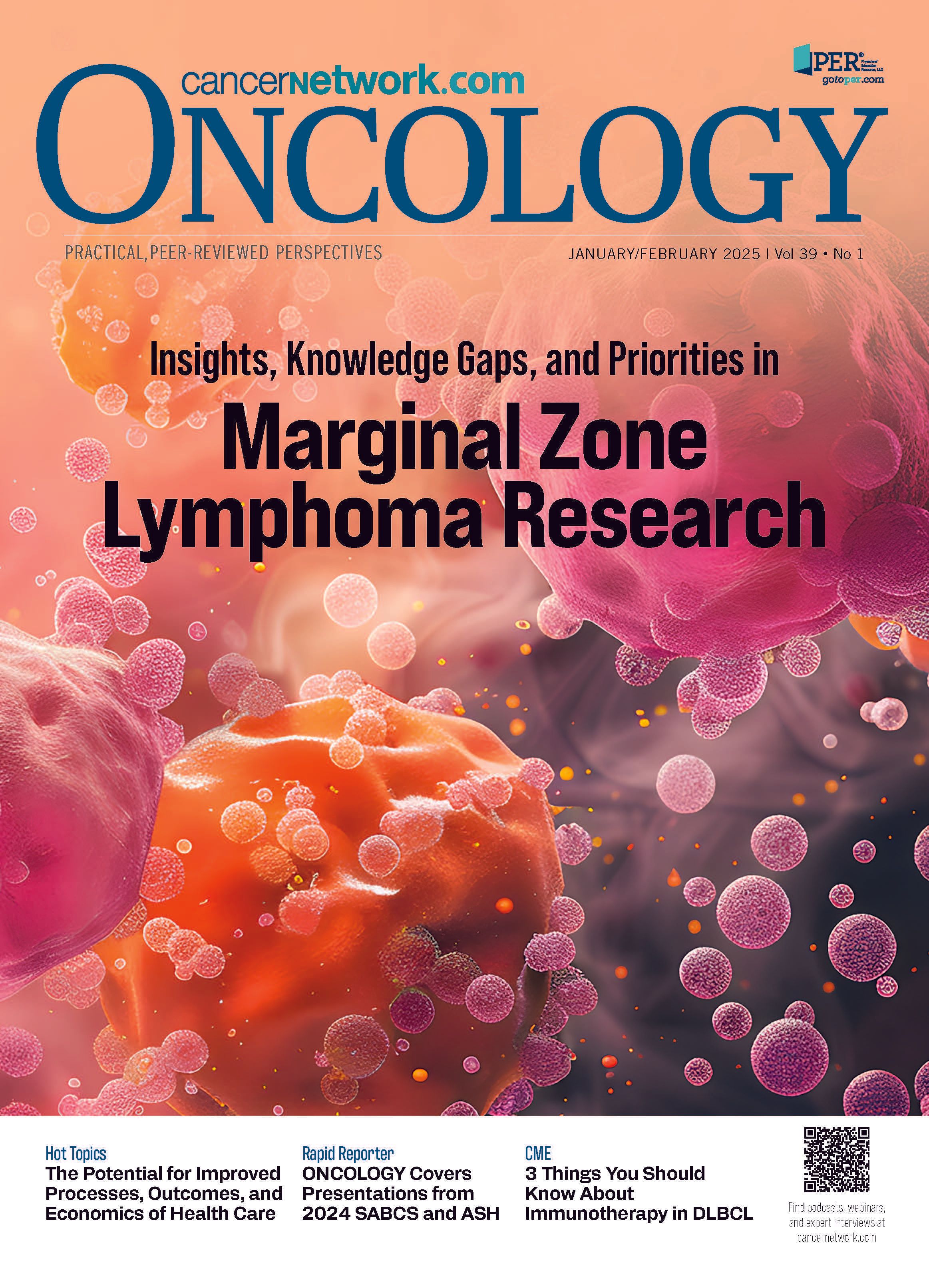Highlighting Quality of Life Considerations for MZL Treatment
Juan Alderuccio, MD, discussed treatment strategies for MZL, particularly as they relate to quality of life, and the role of prognosis models on treatment.
Juan Alderuccio, MD, discussed treatment strategies for MZL, particularly as they relate to quality of life, and the role of prognosis models on treatment.

Juan Alderuccio, MD, associate professor of medicine in the Division of Hematology at the Sylvester Comprehensive Cancer Center of the University of Miami Miller School of Medicine in Florida, discussed insights related to the treatment, prognosis, and challenges associated with extranodal marginal zone lymphoma (MZL).
Alderuccio spoke with CancerNetwork regarding his presentation from the Lymphoma Research Foundation MZL Workshop about the implications of an observed 10.6-year progression-free survival (PFS) rate in an analysis of extranodal MZL held for treatment strategies and patient counseling, with an emphasis placed on quality of life.
He additionally touched on the role of the mucosa-associated lymphoid tissueInternational Prognostic Index (MALT-IPI) model in MZL, further expressing that its use does not impact treatment selection. He further discussed the impact of disease progression within 2 years of treatment (POD24) and achieving a complete response (CR) on survival outcomes and risk for transformation, and their impacts on treatment response and prognosis assessments.
Alderuccio then outlined challenges associated with PET/CT imaging in MZL, with an emphasis on areas with low fluorodeoxyglucose (FDG) avidity, such as the stomach and ocular adnexa. He discussed issues present with metabolic tumor volume that prevent its use in MZL. Furthermore, Alderuccio expressed a need to engage in more MZL-focused studies, before explaining that a need to adopt MZL-specific response and staging assessments exists in the lymphoma field.
In your analysis of extranodal MZL, you mentioned the PFS rate of 10.6 years. What are the implications of this long PFS for treatment strategies and patient counseling?
Alderuccio: When we performed this analysis, we included 411 patients with extranodal MZL. What is important to mention is that the majority of these patients received treatment, and a large proportion had localized disease treated with radiation therapy––approximately 60% of the patients. This long PFS of more than 10 years underscores excellent outcomes of patients with localized extranodal MZL treated with radiation therapy. Thus, when it is possible, remains the preferred treatment strategy in this setting. Furthermore, prognosis was overall good regardless of whether the patient receives radiation therapy or [another] type of systemic therapy, underscoring the disease behavior is largely indolent. With the current therapies, patients are able to have long-term [PFS].
Regarding treatment selection, it is important to evaluate the potential toxicity of the therapies, as most of these patients have an indolent disease course. It is important to consider quality of life and other metrics for treatment selection. For the future development of clinical trials, this needs to be highly considered, because with such a long PFS, quality of life is a major metric that needs to be considered in drug development in MZL.
How do you weigh the MALT-IPI score in treatment decisions for patients with extranodal MZL, and how does that influence your initial choice of therapy?
Alderuccio: The MALT-IPI is a prognosis model that was developed from the only randomized phase 3 clinical trial in extranodal MZL, called IELSG-19 [NCT00210353].1 Patients received single-agent rituximab [Rituxan] or chlorambucil [Leukeran] or chlorambucil plus rituximab. This model was constructed based on 3 variables––age greater than 70 years old, advanced-stage disease, and elevated lactate dehydrogenase levels. In clinical practice, the MALT-IPI helps to risk-stratify patients. Unfortunately, we do not decide on treatments based on the MALT-IPI
Currently, we do not perform treatment selection based on any prognosis model, overall, in lymphoma. The only exception is in patients with large B-cell lymphoma demonstrating an IPI score of 2 or more .... the phase 3 POLARIX trial [NCT03274492], demonstrated longer PFS in patients treated with POLA-R-CHP [polatuzumab vedotin-piiq (Polivy), rituximab, cyclophosphamide (Cytoxan), doxorubicin (Lipodox), and prednisone (Rayos)].2 Besides that specific example, in the other lymphomas, specifically MZL, we do not [consider prognosis model use] in treatment selection.
In your presentation, you emphasize the importance of POD24 and achieving a CR in MZL. How do you incorporate those factors into your assessment of treatment responses and prognosis?
Alderuccio: That is an important point––achieving a CR after frontline therapy was associated with better survival, but also with a lower risk of high-grade transformation to large B-cell lymphoma, an event that has been associated with shorter survival across multiple studies.... . Importantly, e conducted a retrospective study in 237 patients treated with bendamustine [Bendeka] rituximab, and we observed that the CR rate was 81%, and there were very few cases of progression of disease within 24 months.3 In patients with advanced-stage extranodal MZL, bendamustine rituximab seems to be the regimen associated with higher complete responses, longer PFS, and lower incidence of POD24. We observed higher than reported incidence of herpes-zoster and prophylaxis should be included when this regimen is selected.
POD24 is a concept that was extrapolated from the LymphoCare study in follicular lymphoma, where it was defined as progression of disease within 24 months after immunochemotherapy with R-CHOP [rituximab, cyclophosphamide, doxorubicin, vincristine (Oncovin), and prednisone] and most recently with bendamustine rituximab. In MZL, single-agent rituximab is still commonly used, especially in splenic marginal zone lymphoma, and studies confirming shorter survival in MZL also included patients treated with this agent. Thus, this is an important caveat to consider when selecting second-line and beyond therapies in relapsed/refractory MZL.
Looking at the other part of your presentation of PET and CT imaging, what are the current limitations of that in this disease and how do you address the challenges in your practice?
Alderuccio: The limitation of PET/CT in extranodal MZL is that some specific areas have low FDG avidity, such as the stomach and the ocular adnexa. The reason for this is those lesions are usually small and located in an areas with high physiologic background FDG avidity. For example, the ocular adnexa is close to the brain, which is highly FDG avid, so these lesions cannot be seen well on the PET/CT. The stomach and all the gastrointestinal tract are normally highly FDG avid. Small lesions are difficult to differentiate from the physiologic background giving the erroneous conception that MZL is a nonFDG avid disease.
In clinical practice, if the lesion is located inthe ocular adnexa, we usually perform PET/CT and an MRI of the eye that will better define those areas. For the gastrointestinal tract, especially in the stomach, we usually perform upper endoscopies with random biopsies that also help us to assess the response using the GELA histological grading system.
At our institution, we have been conducting staging PET/CT and CT with contrast, or MRI, depending on the disease location. In those patients with baseline FDG avid disease, we select PET/CT for response assessment. However, in patients with no baseline FDG-avid disease, then we conduct response assessment with CT, or with MRI.
Are you able to expand on how FDG avidity works with PET/CT and correlates with disease activity and the prognosis in different MZL subtypes?
Alderuccio: Metabolic tumor volume is an important biomarker associated with survival in lymphoma that accurately reflects the overall FDG-avid tumor burden. Metabolic tumor volume is calculated by setting a specific SUV threshold, commonly 41% of SUVmax or SUV of 4 or more, and the volumes of individual lesions are then added to derive the total tumor volume.
The challenge in extranodal MZL is that a significant number of patients will have small areas of disease located in organs with high FDG-avidity. This characteristic will make it difficult to calculate tumor volumes accurately. Furthermore, the role of metabolic tumor volume in patients with localized disease remains poorly understood. Another challenge is in splenic MZL where the bone marrow is regularly involved and remains problematic the inclusion of this tissue in tumor volume calculations.
Another PET/CT metric is SUVmax. However, the correlation between pretreatment FDG-avidity and prognosis in lymphoma remains unclear with some studies demonstrating worse outcomes in those with high pretreatment SUVmax in follicular lymphoma. In clinical practice, PET/CT also aids in the selection of areas with significantly higher SUVmax for tissue biopsy to rule out transformation to aggressive lymphoma. This event is highly relevant and informs treatment selection as transformation to large B-cell lymphoma requires an anthracycline-based regimen.
Where do you see this field headed when you look toward the future?
Alderuccio: Compared with follicular lymphoma and large B-cell lymphoma, MZL is behind in drug development. Usually, most of the treatment data have originated in studies enrolling patients with follicular lymphoma and MZL. For example, the phase 3 BRIGHT trial [NCT00877006] and the phase 3 StiL NHL 1-2003 trial [NCT00991211] enrolled both histologies diseases, but study cohorts were largely composed of follicular lymphoma and MZL patients were evaluated as a single group.4,5 The field needs to move now to focus on [MZL-based] studies, and ideally in the different subtypes. For example, different toxicities have been reported with bendamustine rituximab in extranodal MZL and splenic MZL. The [phase 2 BRISMA/IELSG36 trial (NCT02853370)].6 evaluated the safety and efficacy of this regimen in splenic MZL, reporting a higher incidence of infections compared to prior reports in extranodal MZL. Finally, fixed-duration programs are highly desired in indolent diseases such as MZL.
Also, the disease biology and clinical presentation are unique for each MZL subtype, underscoring the need for MZL-specific staging and response assessment criteria in practice and clinical trials. Finally, MZL is a rare disease, and multicenter efforts are needed to quickly complete accruing goals in clinical trials testing novel agents that may impact practice.
Is there anything else that you wanted to discuss today that we may not have touched on?
Alderuccio: It is important to highlight the need to consider modifications in the current Lugano classification towards MZL-specific criteria for staging and response assessment. For example, patients with extranodal disease <1.0 cm on scans do not present measurable disease by the current classification being a common scenario in extranodal MZL. Similarly, patients with splenic MZL may present a spleen <13 cm but symptoms and/or cytopenias and have diffuse FDG-avidity of the spleen. Based on the current classification, these patients may not be eligible for clinical trials.
Finally, I would like to mention again the need to incorporate quality-of-life metrics as clinical trial endpoints and the development of fixed-duration therapies for a disease largely characterized by indolent behavior.
References
- Zucca E, Conconi A, Martinelli G, et al. Final results of the IELSG-19 randomized trial of mucosa-associated lymphoid tissue lymphoma: improved event-free and progression-free survival with rituximab plus chlorambucil versus either chlorambucil or rituximab monotherapy. J Clin Oncol. 2017;35(17):1905-1912. doi:10.1200/JCO.2016.70.6994
- Tilly H, Morschhauser F, Sehn LH, et al. Polatuzumab vedotin in previously untreated diffuse large B-cell lymphoma. N Engl J Med. 2021;386(4):351-363. doi:10.1056/NEJMoa2115304
- Alderuccio JP, Arcaini L, Watkins MP, et al. An international analysis evaluating frontline bendamustine with rituximab in extranodal marginal zone lymphoma. Blood Adv. 2022;6(7):2035-2044. doi:10.1182/bloodadvances.2021006844
- Flinn IW, van der Jagt R, Kahl B, et al. First-line treatment of patients with indolent non-Hodgkin lymphoma or mantle-cell lymphoma with bendamustine plus rituximab versus R-CHOP or R-CVP: results of the BRIGHT 5-year follow-up study. J Clin Oncol. 2019;37(12):984-991. doi:10.1200/JCO.18.00605
- Rummel MJ, Maschmeyer G, Ganser A, et al. Bendamustine plus rituximab (B-R) versus CHOP plus rituximab (CHOP-R) as first-line treatment in patients with indolent lymphomas: nine-year updated results from the StiL NHL1 study. J Clin Oncol. 2017;35(suppl 15):7501. doi:10.1200/JCO.2017.35.15_suppl.7501
- Iannitto E, Ferrero S, Bommier C, et al. Bendamustine and rituximab as first-line treatment for symptomatic splenic marginal zone lymphoma: long-term outcome and impact of early unmeasurable minimal residual disease attainment from the BRISMA/IELSG36 phase II study. Haematologica. 2024;109(7):2297-2302. doi:10.3324/haematol.2023.284109

Newsletter
Stay up to date on recent advances in the multidisciplinary approach to cancer.
Highlighting Insights From the Marginal Zone Lymphoma Workshop
Clinicians outline the significance of the MZL Workshop, where a gathering of international experts in the field discussed updates in the disease state.